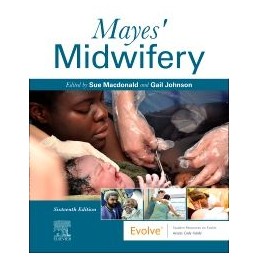- Reduced price

Order to parcel locker

easy pay


 Delivery policy
Delivery policy
Choose Paczkomat Inpost, Orlen Paczka, DHL, DPD or Poczta Polska. Click for more details
 Security policy
Security policy
Pay with a quick bank transfer, payment card or cash on delivery. Click for more details
 Return policy
Return policy
If you are a consumer, you can return the goods within 14 days. Click for more details
Mayes Midwifery is a core text for students in the UK, known and loved for its in-depth approach and its close alignment with curricula and practice in this country. The sixteenth edition has been fully updated by leading midwifery educators Sue Macdonald and Gail Johnson, and input from several new expert contributors ensures this book remains at the cutting edge.
The text covers all the main aspects of midwifery in detail, including the various stages of pregnancy, possible complexities around childbirth, and psychological and social considerations related to womens health. It provides the most recent evidence along with detailed anatomy and physiology information, and how these translate into practice.
Packed full of case studies, reflective activities and images, and accompanied by an ancillary website with 600 multiple choice questions and downloadable images, Mayes Midwifery makes learning easy for nursing students entering the profession as well as midwives returning to practice and qualified midwives working in different settings in the UK and overseas.
Data sheet
Part 1: The midwife in context
1. Global midwifery - an international perspective
2. An introduction to midwifery history in the United Kingdom
3. The regulation of midwives
4. Clinical governance and the midwife
5. Learning, being, and developing as a midwife
6. Being a student midwife
7. Evidence-based practice and research for practice
8. Leadership and management in midwifery
9. An introduction to ethics for midwifery practice
10. Law and the midwife
11. Pharmacology and the midwife
Part 2: Childbirth in context
12. Sociocultural and spiritual context of childbearing
13. Psychological context of childbirth
14. Sex, gender, sexuality, and childbearing
15. National Health Service policy and midwifery
16. Maternity service provision
17. Legal frameworks for the care of the child
Part 3: Public health, health promotion in the context of childbirth
18. Epidemiology
19. Infection prevention and control in maternity care
20. Nutrition for a healthy pregnancy
21. Complementary therapies and natural remedies in pregnancy and birth
22. Public health, health promotion, and education
23. Preconception care
24. Education for parenthood
25. Physical preparation for childbirth and beyond
26. Vulnerable women and families
Part 4 The anatomy and physiology of fertility, conception and pregnancy
27. Anatomy of male and female reproduction
28. Female reproductive physiology - cyclical changes in the ovaries, uterus, and mammary gland, across the infertile cycle
29. Genetics and genomics
30. Fertility and its control
31. Infertility and assisted conception
32. From fertilisation to feto-placental development
33. The fetal skull
Part 5 Pregnancy
34. Maternal cardiovascular, respiratory, haemodynamic, uterine, and gastrointestinal-mammary adaptations to the fertile cycle
35. Antenatal care
36. Antenatal investigations
37. The choice and personalisation agenda
Part 6 Labour and birth
38. Neuroendocrinology of parenting: from nocturnal uterine activation to suckling-lactation and emotional connectivity between parents and infant
39. Care in the first stage of labour
40. Care in the second stage of labour
41. Supporting choices in reducing pain and fear during labour
42. Care in the third stage of labour
43. The pelvic floor
Part 7 Postnatal care and the care of the newborn baby
44. Women and family-centred postnatal care
45. Physiology, assessment, and care of the newborn
46. Thermoregulation
47. Infant feeding and relationship building
Part 8 Women and babies with complex needs
48. The preterm baby and the small baby
49. Respiratory and cardiac disorders in the neonate
50. Neonatal jaundice
51. Neonatal infection
52. Congenital anomalies and metabolic and endocrine disorders
53. Pregnancy loss and baby deaths
54. Nausea and vomiting
55. Bleeding in pregnancy
56. Hypertensive and medical disorders in pregnancy
57. Sexually transmitted infections
58. Abnormalities and anomalies of the genital tract
59. Multiple pregnancy and birth
60. Preterm labour and birth
61. Induction of labour and post-term pregnancy
62. Presentation and prolapse of the umbilical cord
63. Rhythmic variations of labour
64. Malpositions and malpresentations
65. Obstructed labour and uterine rupture
66. Obstetric interventions
67. Shoulder dystocia
68. Complications related to the third stage of labour
69. Maternal morbidity following childbirth
70. Mental health and well being in pregnancy and childbirth
71. Pregnancy loss and the death of a baby
72. Midwifery - practising in a complex world
